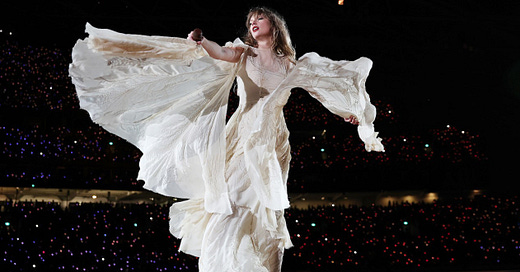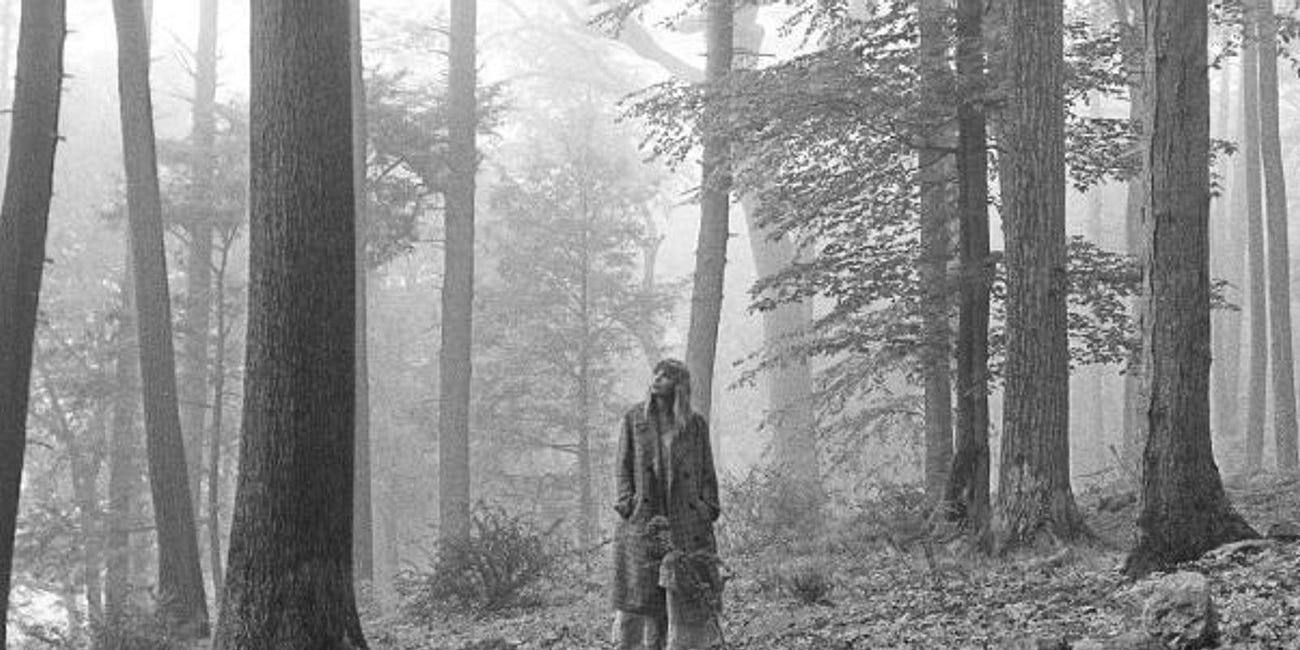The Poet as Haunted and Hunted: A Literary Review of Taylor Swift’s “The Albatross”
PopPoetry's coverage of The Tortured Poets Department and all things Taylor Swift continues.
You’re reading a guest post by Isabella Vega. Isabella is a people journalist, word lover, and dreamer. She hopes every piece makes a home within your soul, and writes to elevate the truthful romanticism of living. She is an editor at FilmDaze and her work has appeared in Remezcla, Galore, and Euphoria Magazine. Isabella is launching her own Substack, Points of Convergence: a corner of the internet for fellow restless wanderers. If you’d like to work with Isabella, you can reach her at writerbella31@gmail.com.
Taylor Swift’s “The Albatross” originally appeared as a version-exclusive track for fans who bought “The Albatross” variant of her The Tortured Poets Department album. Poets, Swifties, and skeptics alike (and, like me, those rare folks who find themselves all three) waited with bated breath for this song’s contents, some already drawing comparisons between the literary uses of the albatross and what Swift was most likely trying to say without first listening to the song.
In literary canon, the most popular comparison to a song called “The Albatross” would obviously be “The Rime of the Ancient Mariner” by Samuel Taylor Coleridge, the epic lyrical poem wherein an unassuming sailor shoots down an albatross, a symbol of the divine in nature. The killing of the bird causes supernatural danger, leading to his eventual insanity and a memorable scene where he wears the dead albatross around his neck, having succumbed to his madness. It feels almost too easy to make the comparison between Swift’s theme of victimization and the dead albatross featured in the poem, a once grand thing now dead and hung around a powerful man’s neck. In that reading, “The Albatross” would be a song much like “My Tears Ricochet,” making her an unwilling martyr to both a world that reveres her and a lover doomed to never escape her memory.
However, Swift’s “The Albatross” features this refrain: “Cross your thoughtless heart / Only liquor anoints you / She’s the Albatross / She is here to destroy you… She’s the death you chose / she is here to destroy you.” She sings with a sort of sweetness laced with pain, not exactly like an old folk singer singing a story traded around firelight with a fellow wandering stranger, but like the albatross herself, singing about the scars still left on her wings. The wording of the chorus suggests an active wish to do harm, a corroded malice, on behalf of the person who killed her—she taunts him with his drunken stupor and inability to feel, and mentions that he chose her: he made his bed and must lie in it. This is no accident. No apologies that can somehow make this suffering better—they meant the harm they did, mercilessly.
For this reason, there seems to be a more on-par comparison to be made by comparing Swift’s “The Albatross” to Charles Baudelaire’s 1859 work “L’Albatros,” whose original French text I’ve spent years poring over. Instead of the repetitive generalization that this is merely “another Taylor Swift plays the victim song,” contrasting these two pieces provides a more nuanced and emotionally textured understanding of Swift’s emotional state towards not just a lover, but the world around her—Swifties and the general public alike.
Looking at Baudelaire’s work through the lens of Swift’s song, the sailor Swift is singing to offers a double meaning. Swift isn’t a martyred animal but something far worse and more gruesome: As every famous woman is, she’s forced to live a life full of simultaneous awe-struck fascination and unfair disgust. The very same people who watched her fly with wonder would just as soon nail her wings to the helms of their ships and take pleasure in her struggling form. Furthermore, the sailors not only represent the changing tides of public opinion that torture Swift’s existence, but also the cruelty of the lover that Swift is singing to, a lover who seemingly chose Swift only to sabotage her in a myriad of ways.
We can connect this idea to a lyric in the ballad “loml” (which ingeniously stands for loss of my life). The track is allegedly about Swift’s long-term relationship and features one hell of a bridge: “You shit-talked me under the table / talking rings and talking cradles.” Again, the inherent fascination, reverence, and deep disgust she faces from the general public as one of the most famous women in the world is well understood, but what about the feelings of her lover? It seems here like the very same sailor she taunts, drunk and lying, chose the “terrible danger” of her life only to discard her when it no longer served him. The same man who watched her fly is now nailing her wings to the boards of his ship and laughing at the fear in her eyes.

Swift uses colors to represent not only basic emotions but also her unfurling and ever-changing understanding of different aspects of life. For example, love is represented as red, fiery passion on her 2012 album, Red, re-recorded as Red (Taylor’s Version) in 2021). Later, it’s represented as golden on her albums Lover (2019) and Folklore (2020) because she had found peace within it. Blue, throughout her discography (and indeed throughout history in art), is associated with sadness. Swift said in an interview that one of her favorite lyrics she’s ever written was “Don’t want no other shade of blue but you” from Folklore. To her, this lyric represented loving someone so deeply that their sadness felt beautiful to you, that you wanted their hard times as desperately as you wanted their good ones. Throughout The Tortured Poets Department, we see Swift become emotionally overshadowed by this shade of blue she once spoke so highly of—she mentions in “Guilty as Sin” that she’s “drowning in the blue Nile.” This directly correlates to the idea of Swift as the albatross, a thing of great beauty having terrible danger inflicted upon it. This also brings to mind Baudelaire’s description of albatrosses as the “rois de l’azur, maladroits et honteux” (kings of blue, awkward and ashamed).
What both Baudelaire and Swift are getting at in their respective works is that the albatrosses are the poets. These poems and songs are not simply stories by onlookers to tragedies—they are the subjects themselves. With maimed wings that were too grand, they can no longer fly. It seems as if the life the man in the song chose with Swift was one of grandeur, which at first must have been exciting, if abnormal. But the more her wings grew, the more he wanted to tie her down until her wings ended up being the very thing keeping her exiled to the soil, stranded and unable to move.
Related
The Torture & The Poets of Taylor Swift's The Tortured Poets Department
It’s National Poetry Month! If you feel like this writing on poetry and pop culture has added value to your life, I’d be so grateful to have you consider supporting my work further by becoming a paid subscriber. Beyond supporting me, an only somewhat tortured poet, your dollars also allow me to pay guest writers and make the future of this publication p…
Taylor Swift's "The Lakes" Gets Romantic (Poetry, That Is)
PopPoetry is poetry and pop culture Substack written by Caitlin Cowan. If you like what you read and want it in your inbox weekly, subscribe below so you won’t miss a post! Thanks for reading and sharing. If you’d told me five years ago that I’d be blogging about Taylor Swift’s reference to Romantic Poetry, I would have slapped your cardigan out of your…









I love this analysis!! I did a whole write-up on TTPD in this morning's newsletter and I included a shoutout to PopPoetry but I didn't even know this was coming!
From what I've been told, the reference to "the Blue Nile" is intended as a swipe at her ex's musical taste, as he was apparently a big fan of the excellent Scottish post-punk band the Blue Nile: https://en.wikipedia.org/wiki/The_Blue_Nile_(band), who in turn named themselves after the Alan Moorehead novel The Blue Nile.
If you'd asked me two years ago which post-punk artist would get a dose of unlikely fame à la Kate Bush via Stranger Things, the Blue Nile wouldn't have even cracked my top 100 guesses, and in all honesty, I have mixed feelings about the whole thing.